- Benefits and Purpose of Tree Whitewashing
- 1. Protection from Harsh Weather Conditions
- 2. Preventing Sunscald and Heat Stress
- 3. Deterring Pest Infestation
- 4. Enhancing Tree Aesthetics
- 5. Health Monitoring
- Choosing the Right Time to Whitewash Trees
- Preparation and Materials for Tree Whitewashing
- Materials needed:
- Preparation steps:
- The Whitewashing Process Step-by-Step
- Materials Needed:
- Step 1: Prepare the Whitewash Solution
- Step 2: Choose the Right Time
- Step 3: Protect Yourself and the Surroundings
- Step 4: Apply the Whitewash Solution
- Step 5: Reach Higher Branches
- Step 6: Check for Coverage
- Step 7: Clean Up
- Step 8: Monitor and Reapply
- Preventing and Treating Tree Diseases with Whitewashing
- Preventive Benefits of Whitewashing
- Treating Tree Diseases with Whitewashing
- Conclusion
- Importance of Whitewashing Fruit Trees in Autumn
- 1. Protection from Temperature Fluctuations
- 2. Prevention of Sunscald
- 3. Defense against Pests and Diseases
- 4. Prevention of Cracks and Splits
- 5. Aesthetic Benefits
- Conclusion
- Proper Whitewashing Techniques for Different Tree Types
- 1. Deciduous Trees
- 2. Evergreen Trees
- 3. Fruit Trees
- Common Mistakes to Avoid When Whitewashing Trees
- “Question-Answer”
- Why should I whitewash my trees in autumn?
- When is the best time to whitewash trees in autumn?
- What materials are needed to whitewash trees in autumn?
- How do I properly whitewash a tree in autumn?
- Can I use any type of paint for whitewashing trees in autumn?
- “Video” Put aluminum foil in your toilet…and THIS will Happen! (Dollar Tree Trick)
As the leaves start to change color and the temperatures begin to drop, autumn is a great time to take care of your trees. One common practice during this season is whitewashing. Whitewashing is the process of applying a thin mixture of lime, water, and other additives to the trunks and branches of trees. It offers several benefits and can help to protect your trees during the harsh winter months.
Whitewashing has been used for centuries as a method to protect trees from the elements. The thick coat of whitewash acts like a sunscreen, reflecting the sunlight and reducing temperature fluctuations. This can help to prevent damage caused by intense heat or extreme cold. Additionally, the whitewash serves as a barrier against insects, diseases, and fungi that may harm the tree.
When it comes to whitewashing, timing is crucial. It is best to do it in late autumn, after the leaves have fallen off. This way, you can have a clear view of the tree’s structure and any areas that might need some extra attention. Before applying the whitewash, make sure to clean the tree’s trunk and branches to remove any debris or moss. This will ensure better adhesion of the whitewash and a more effective protection.
To create the whitewash mixture, combine hydrated lime with water in a ratio of 1:1. Add small amounts of water and mix thoroughly until you reach a creamy consistency. For extra protection against insects and fungi, you can include additives such as copper sulfate or sulfur in the mixture. Once the mixture is ready, use a brush or a roller to apply a thin, even coat to the tree’s trunk and branches, starting from the bottom and working your way up.
Overall, whitewashing your trees in autumn can provide significant benefits for their health and protection. By taking the time to perform this task, you can increase the chances of your trees thriving throughout the winter and coming back strong in the spring.
Benefits and Purpose of Tree Whitewashing
Whitewashing trees is a common practice that has been used for centuries to protect trees from various environmental factors. It involves applying a mixture of lime, water, and other additives to the trunk and branches of trees to create a protective coating. This protective coating has several benefits and serves multiple purposes.
1. Protection from Harsh Weather Conditions
One of the main purposes of tree whitewashing is to protect trees from harsh weather conditions, especially during the winter months. The layer of whitewash acts as an insulating barrier that helps to keep the trees warm and prevents damage from frost and freezing temperatures. It also provides protection against strong winds, which can cause branches to break or uproot the entire tree.
2. Preventing Sunscald and Heat Stress
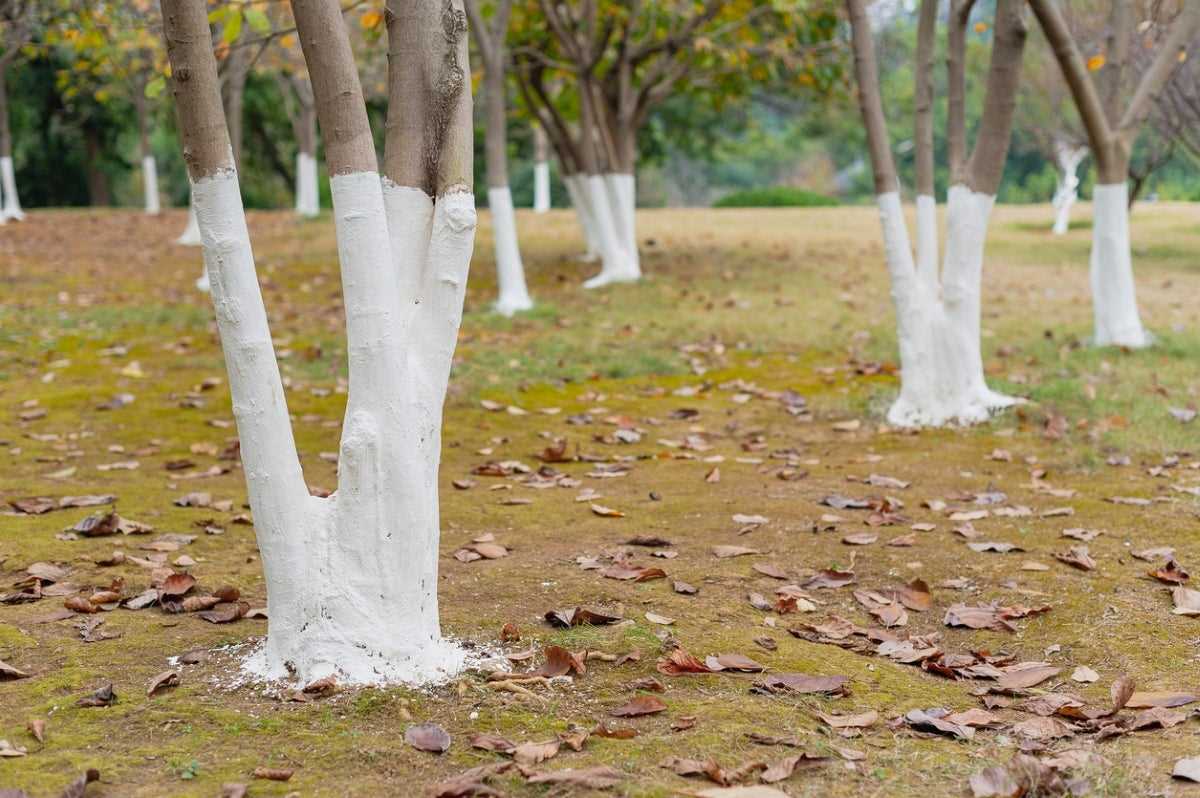
Another important benefit of tree whitewashing is its ability to prevent sunscald and heat stress. Sunscald occurs when the bark of a tree is exposed to intense sunlight, leading to cracks and tissue damage. Whitewashing the trees can help reflect the sunlight and reduce the chances of sunscald. It also helps to keep the trees cool by reflecting the sun’s heat.
3. Deterring Pest Infestation
Tree whitewashing can act as a deterrent against certain pests that are attracted to the bark of trees. The bright white color of the whitewash can repel insects, such as aphids and borers, which are known to damage trees by feeding on their bark and causing diseases. By creating a barrier between the pests and the tree, whitewashing can help prevent infestations and protect the overall health of the trees.
4. Enhancing Tree Aesthetics
Whitewashing trees can also serve an aesthetic purpose. The bright white color of the whitewash creates a striking contrast against the trees’ foliage, making them more visually appealing. It can also help highlight the shape and structure of the trees, especially during the winter months when they may appear barren. Additionally, whitewashing can give older trees a rejuvenated appearance by covering up blemishes and scars on the trunk.
5. Health Monitoring
Whitewashing trees can also help in monitoring the health and condition of the trees. The whitewash coating makes it easier to detect any signs of diseases or insect infestations on the bark. It also helps to identify areas where the bark has become damaged or weakened, which can be indicative of underlying issues. By regularly inspecting the whitewashed trees, arborists can identify potential problems and take necessary measures to prevent further damage.
In conclusion, tree whitewashing provides a range of benefits and serves various purposes. It protects trees from harsh weather conditions, prevents sunscald and heat stress, deters pest infestation, enhances tree aesthetics, and aids in health monitoring. By investing in tree whitewashing, you can ensure the health and longevity of your trees while adding visual appeal to your landscape.
Choosing the Right Time to Whitewash Trees
Whitewashing trees is an important practice that can help protect them from various environmental factors and diseases. However, it is crucial to choose the right time to apply whitewash to ensure its effectiveness. Here are some key factors to consider when deciding when to whitewash trees:
- Season: The best time to whitewash trees is during the late autumn or early winter. This is because the trees have shed their leaves and are in a dormant state. The absence of leaves allows for better coverage and adherence of the whitewash to the tree trunk and branches.
- Weather: It is important to choose a day with favorable weather conditions for whitewashing trees. Avoid applying whitewash on a rainy or windy day, as the moisture can affect the adherence of the whitewash and wash it away. Also, make sure the temperature is above freezing to avoid freezing of the whitewash.
- Disease and pest activity: Whitewashing trees can help prevent certain diseases and pests. It is important to monitor the tree for any signs of diseases or pest infestation. If you notice any issues, it is best to address them before applying whitewash. Consulting with a professional arborist can help identify any potential problems and provide guidance on the timing of whitewashing.
- Growth stage: The growth stage of the tree can also impact the timing of whitewashing. Newly planted or young trees may benefit from whitewashing to protect their thin bark from extreme temperatures and sunburn. Mature trees with thicker bark are less susceptible to these issues and may not require whitewashing.
By considering these factors, you can choose the right time to whitewash your trees and ensure their protection. Remember to follow proper whitewashing techniques and use high-quality whitewash products to achieve the best results.
Preparation and Materials for Tree Whitewashing
Whitewashing trees is a simple and effective way to protect them from winter damage and pests. Before you begin the whitewashing process, it’s important to gather the necessary materials and prepare the trees properly.
Materials needed:
- Lime-based whitewash: Choose a lime-based whitewash instead of paint, as it allows the tree to breathe and prevents moisture buildup. You can purchase ready-to-use whitewash or make your own by mixing hydrated lime with water.
- Brush or sprayer: Depending on the size of the tree, you can use a brush or sprayer to apply the whitewash evenly.
- Gloves and protective clothing: Wear gloves and clothing that you don’t mind getting dirty to protect yourself from the whitewash.
- Ladder or sturdy platform: Make sure you have a stable surface, such as a ladder or sturdy platform, to reach the upper branches of the tree.
- Clean water: Keep a bucket of clean water nearby to rinse the brush or sprayer between tree whitewashing sessions.
Preparation steps:
- Clean the tree: Before applying the whitewash, remove any loose bark, dirt, or debris from the tree trunk and branches. Use a soft brush or cloth to gently scrub the surface.
- Prune the tree: Trim away any dead or broken branches to promote the tree’s overall health. This will also help create a clean surface for the whitewash to adhere to.
- Protect surrounding areas: If there are plants or structures near the tree, cover them with plastic sheets or tarps to prevent any accidental whitewash splatters.
- Choose the right weather conditions: Whitewashing should be done on a clear, dry day when the temperature is above 45°F (7°C). Avoid windy days to ensure the whitewash adheres properly.
By gathering the necessary materials and properly preparing the trees before whitewashing, you can ensure a successful application and provide the trees with the protection they need during the autumn season.
The Whitewashing Process Step-by-Step
Materials Needed:
- Whitewash solution
- Paintbrush or sprayer
- Protective clothing and gloves
- Ladder or extension pole
- Bucket or container
- Water
- Clean cloth or sponge
Step 1: Prepare the Whitewash Solution
Start by preparing the whitewash solution. You can purchase pre-made whitewash, or make your own by mixing equal parts of white latex paint and water. Stir the solution well until it is smooth and free of lumps.
Step 2: Choose the Right Time
It is important to choose the right time to whitewash the trees. Ideally, it should be done in late autumn or early winter, when the trees have shed most of their leaves and are in a dormant state.
Step 3: Protect Yourself and the Surroundings
Before starting the whitewashing process, make sure to wear appropriate protective clothing, such as old clothes, gloves, and goggles. Also, cover the ground and surrounding plants with a drop cloth or plastic sheet to protect them from splatters.
Step 4: Apply the Whitewash Solution
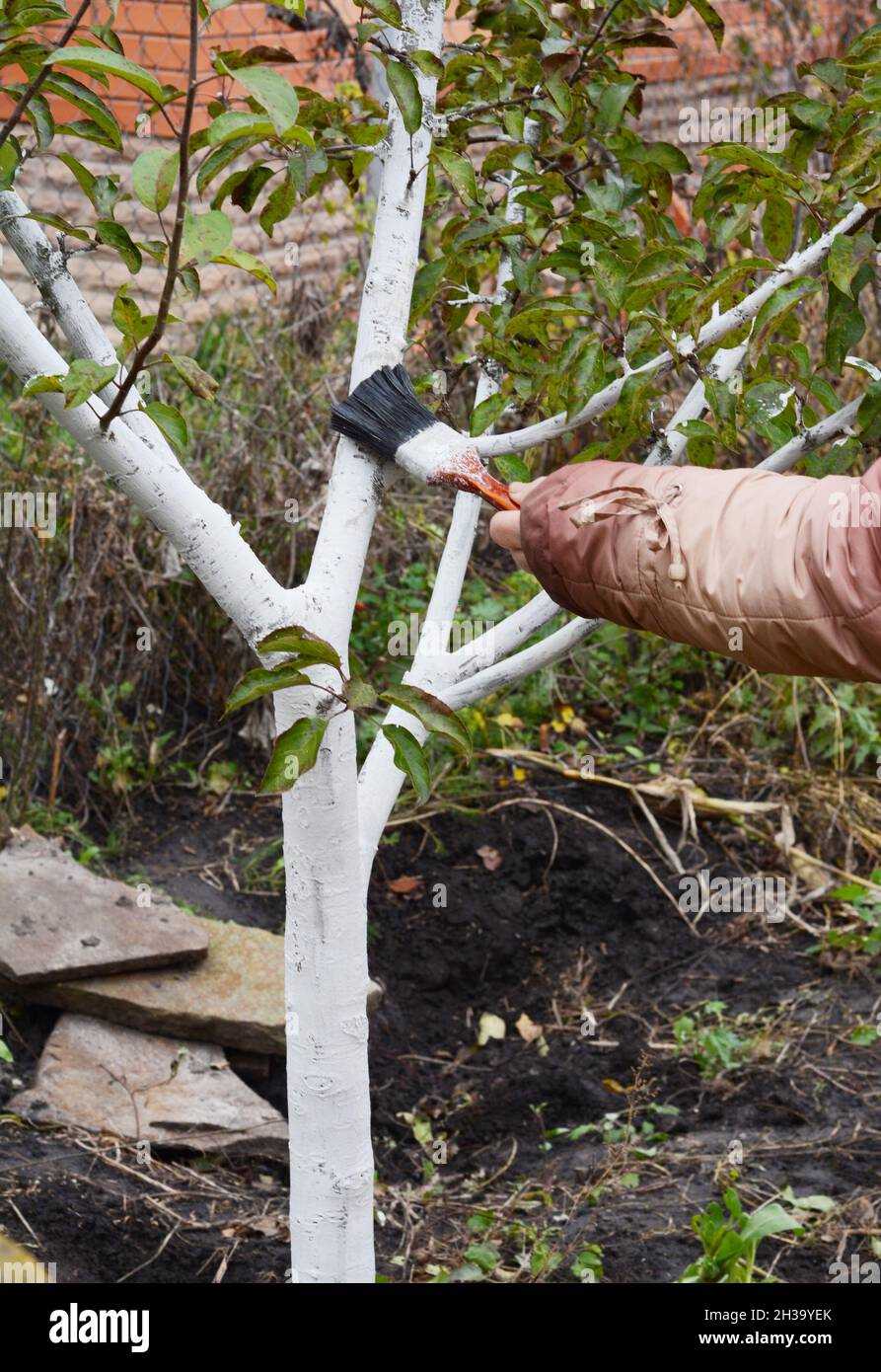
Using a paintbrush or sprayer, apply the whitewash solution to the trunks and main branches of the trees. Start from the bottom and work your way up, ensuring thorough coverage on all sides. If using a sprayer, adjust the nozzle for a fine mist.
Step 5: Reach Higher Branches
If the trees have higher branches that are difficult to reach, use a ladder or an extension pole to apply the whitewash solution. Be cautious and ensure the ladder or pole is stable before climbing or extending it.
Step 6: Check for Coverage
After applying the whitewash solution, step back and check for any missed spots or uneven coverage. Use a clean cloth or sponge to touch up these areas and ensure that the entire tree is evenly whitewashed.
Step 7: Clean Up
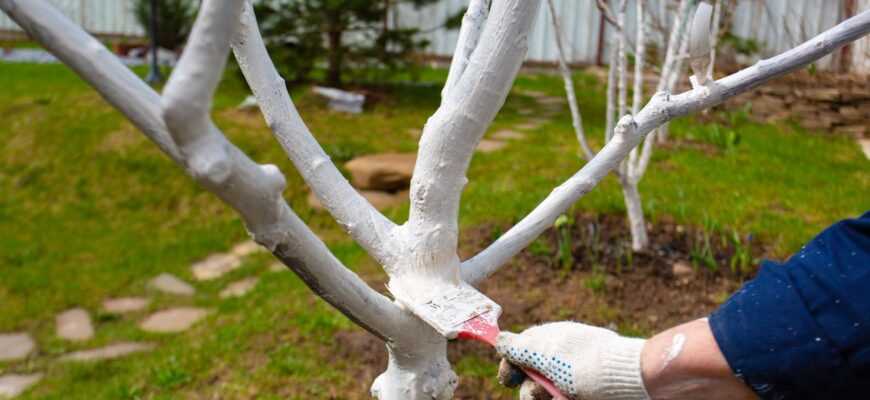
Once you have finished whitewashing the trees, clean up any excess solution or splatters. Rinse your tools in water and dispose of any leftover whitewash properly, following local regulations for the disposal of paint products.
Step 8: Monitor and Reapply
Monitor the condition of the whitewashed trees throughout the winter and early spring. If you notice any signs of sunscald or damage, reapply the whitewash solution to provide additional protection.
Remember, whitewashing trees is a practice that has been used for centuries to protect them from winter sunscald, pests, and fungal diseases. By following these steps and taking the time to properly whitewash your trees, you can help ensure their health and longevity.
Preventing and Treating Tree Diseases with Whitewashing
Whitewashing trees in autumn not only helps protect them from extreme weather conditions, but it can also prevent and treat various tree diseases. Whitewash acts as a physical barrier, providing a layer of protection against harmful elements that can lead to disease.
Preventive Benefits of Whitewashing
- Protects against sun damage: Whitewashing trees helps reflect sunlight, reducing the risk of sunscald and sunburn. These conditions occur when intense sunlight causes damage to the bark, leading to cracks, cankers, or blisters.
- Prevents frost cracks: Applying whitewash to the trunk of a tree can also reduce the occurrence of frost cracks. Frost cracks happen when low temperatures cause the bark to contract and split open, affecting the tree’s overall health.
- Repels insects: Some insects are attracted to the dark, rough surface of a tree trunk. By whitewashing the bark, you create a smooth, bright surface that makes it difficult for insects to crawl or lay eggs.
Treating Tree Diseases with Whitewashing
In addition to prevention, whitewashing can also be used as a treatment for certain tree diseases. The process of coating the tree trunk with whitewash can help combat the following infections:
- Fungal diseases: Whitewashing creates an unfavorable environment for fungal diseases to thrive. It prevents spores from penetrating the bark and reduces the moisture content on the surface, inhibiting the growth of fungi such as mildew, anthracnose, and canker.
- Bacterial infections: Some bacterial infections can enter a tree through wounds in the bark. Whitewash acts as a barrier that seals off these entry points, preventing the bacteria from infecting the tree further.
- Insect infestations: Whitewash can deter certain insects that are known to cause tree diseases. For example, the application of whitewash near the base of a tree can prevent the ascent of larvae and nymphs that may bore into the trunk.
NOTE: While whitewashing can provide preventive and treatment benefits, it is important to consult with an arborist or tree care professional for specific instructions and advice. They can recommend the best whitewashing techniques and products for your trees, taking into consideration their species, condition, and local climate.
Conclusion
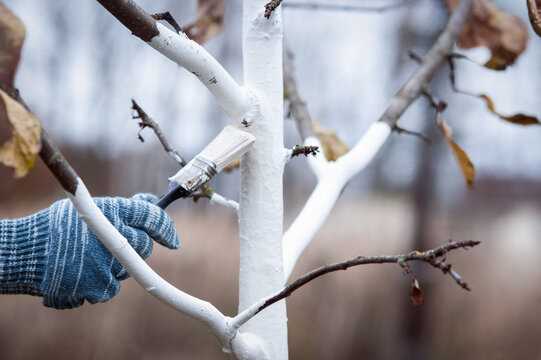
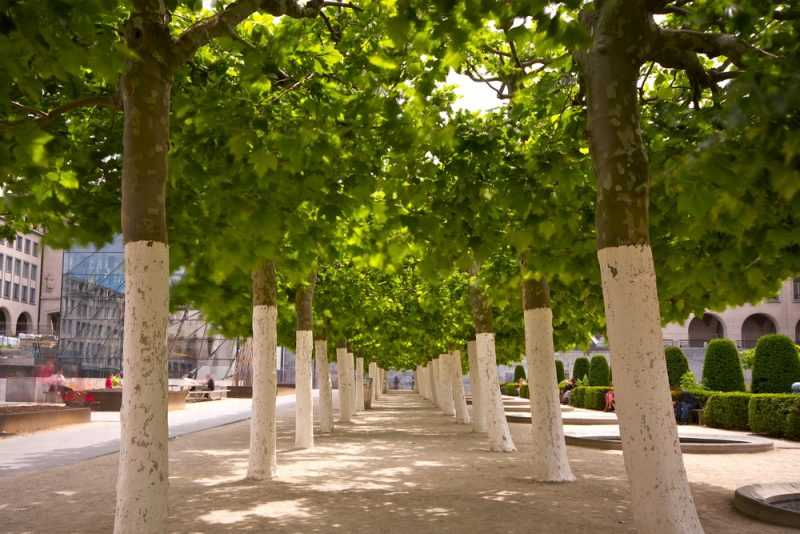
Whitewashing trees in autumn not only offers preventative advantages but can also aid in treating various tree diseases. By acting as a physical barrier, whitewash can protect against sun damage, prevent frost cracks, and repel certain insects. Furthermore, it can help combat fungal diseases, bacterial infections, and insect infestations. For optimal results, seek guidance from a tree care professional who can provide tailored recommendations.
Importance of Whitewashing Fruit Trees in Autumn
1. Protection from Temperature Fluctuations
Whitewashing fruit trees in autumn is crucial for protecting them from drastic temperature changes. The whitewash acts as an insulating layer on the tree trunk, preventing it from experiencing extreme temperature fluctuations that can damage the tree.
2. Prevention of Sunscald
Sunscald is a condition where the bark on the tree trunk becomes damaged due to exposure to harsh sunlight, especially during the winter months. Whitewashing the tree creates a reflective barrier that minimizes the risk of sunscald, keeping the tree healthy and protected.
3. Defense against Pests and Diseases
Whitewashing fruit trees in autumn helps deter pests and diseases that can harm the tree. The bright white color of the whitewash repels insects and can make it easier to spot signs of infestation. Additionally, the paint creates a physical barrier that prevents pests from reaching the tree’s vulnerable trunk and branches.
4. Prevention of Cracks and Splits
As the temperature drops in autumn and winter, the bark on fruit trees can freeze and crack. By applying a layer of whitewash, the tree’s bark is protected from freezing temperatures and moisture, reducing the risk of cracks and splits that can weaken the tree’s structure.
5. Aesthetic Benefits
Aside from its practical advantages, whitewashing fruit trees in autumn can also enhance the overall appearance of the orchard or garden. The bright white color of the paint creates a visually appealing contrast against the tree’s leaves and fruits, adding a touch of beauty to the landscape.
Conclusion
Whitewashing fruit trees in autumn is a simple and effective way to provide essential protection for the trees. By safeguarding against temperature fluctuations, sunscald, pests, diseases, and cracks, the whitewash helps maintain the health and longevity of the fruit trees. Additionally, it provides an aesthetically pleasing element to the garden or orchard. Make sure to apply the whitewash properly and regularly to enjoy all the benefits it offers.
Proper Whitewashing Techniques for Different Tree Types
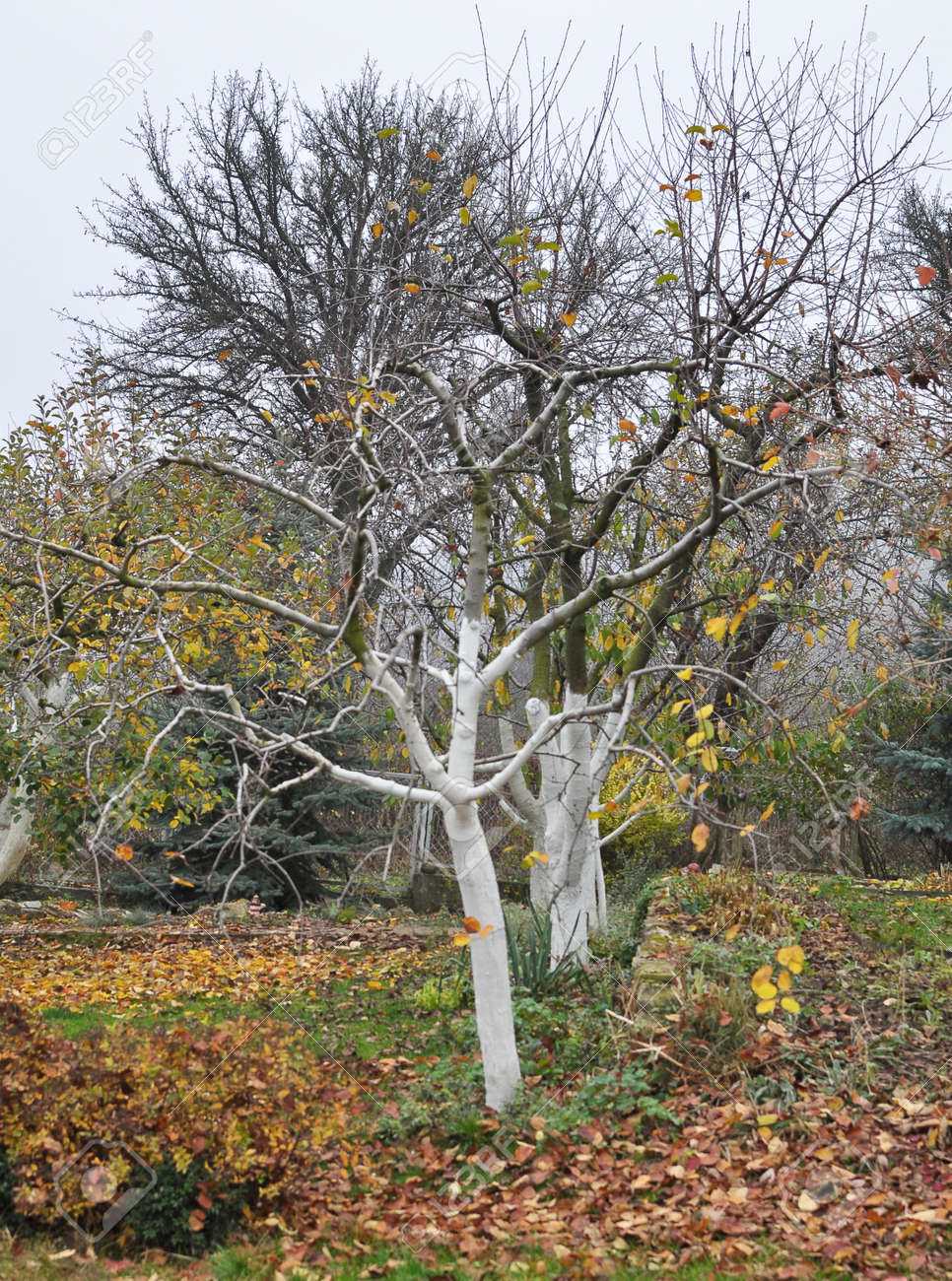
1. Deciduous Trees
Deciduous trees are those that lose their leaves during the winter. Whitewashing these trees is important to protect their bark from the harsh weather conditions and prevent sunscald. Follow these steps for proper whitewashing technique:
- Clean the tree’s trunk with a soft brush to remove any dirt or debris.
- Prepare a whitewash mixture using equal parts of white latex paint and water.
- Apply the whitewash mixture to the tree’s trunk using a brush, starting from the base and working your way up.
- Make sure to cover the entire trunk and any exposed branches.
- Allow the whitewash to dry completely before applying a second coat if needed.
2. Evergreen Trees
Evergreen trees, which keep their leaves all year round, also benefit from whitewashing. The process for whitewashing evergreen trees is slightly different:
- Choose a whitewash product specifically designed for evergreen trees.
- Read and follow the instructions provided by the manufacturer.
- Clean the tree’s trunk with a soft brush.
- Apply the whitewash product using a brush or sprayer, following the manufacturer’s guidelines.
- Make sure to cover the entire trunk and any exposed branches.
- Allow the whitewash to dry completely before applying a second coat if recommended.
3. Fruit Trees
Whitewashing fruit trees not only protects the bark but also helps prevent pests and diseases. Here’s how to do it:
- Clean the tree’s trunk and branches with a soft brush.
- Make a whitewash mixture using equal parts of water and lime.
- Add a small amount of copper sulfate to the mixture to help prevent fungal infections.
- Apply the whitewash mixture using a brush or sprayer, starting from the bottom and working your way up.
- Make sure to cover the entire trunk and any exposed branches.
- Allow the whitewash to dry completely before applying a second coat if necessary.
Proper whitewashing techniques differ depending on the type of trees you have. By following these guidelines, you can ensure that your trees are well-protected and healthy throughout the autumn and winter seasons.
Common Mistakes to Avoid When Whitewashing Trees
Not preparing the tree properly: One of the most common mistakes when whitewashing trees is not properly preparing the tree before applying the whitewash. It is important to remove any loose bark, moss, or lichens from the tree trunk. Cleaning the trunk will ensure that the whitewash adheres well and provides maximum protection to the tree.
Using the wrong type of whitewash: Another mistake to avoid is using the wrong type of whitewash. There are different types of whitewash available, including commercial products and homemade mixtures. It is important to choose a whitewash that is specifically formulated for trees and provides the necessary protection against pests, sunburn, and frost damage.
Applying whitewash too thick: Applying whitewash too thick can actually harm the tree instead of providing protection. Thick layers of whitewash can trap moisture against the trunk, leading to rot and disease. It is recommended to apply a thin and even layer of whitewash, ensuring that the tree trunk can still breathe.
Missing spots or applying unevenly: When whitewashing trees, it is important to cover the entire tree trunk evenly. Leaving spots unwhitewashed can leave those areas vulnerable to damage. Make sure to apply the whitewash in a consistent and even manner, using a brush or sprayer for better coverage.
Not reapplying as needed: Whitewash can wear off over time due to weather conditions. Failing to reapply whitewash as needed can leave the tree exposed to potential damage. It is important to regularly monitor the condition of the whitewash and reapply as necessary to provide ongoing protection to the tree throughout the autumn season.
Ignoring safety precautions: Safety should be a top priority when whitewashing trees. It is important to wear protective clothing, gloves, and eye goggles to avoid contact with the whitewash solution. Additionally, it is recommended to work in a well-ventilated area to avoid inhaling the whitewash fumes.
“Question-Answer”
Why should I whitewash my trees in autumn?
Whitewashing trees in autumn has several benefits. Firstly, it helps to protect the tree from extreme temperature fluctuations, which can damage the bark and underlying tissue. Additionally, whitewashing acts as a barrier against harmful insects and pests, reducing the risk of infestation. Lastly, whitewashing can prevent sun scald, a condition where the bark gets damaged due to intense sunlight during winter months.
When is the best time to whitewash trees in autumn?
The ideal time to whitewash trees in autumn is before the first frost. It is recommended to wait until all the leaves have fallen, and the tree is in a dormant state. This ensures that the whitewash is applied when the tree is less susceptible to damage and the paint will last longer. Late autumn or early winter is usually the best time for whitewashing.
What materials are needed to whitewash trees in autumn?
To whitewash trees in autumn, you will need a few materials. A bucket or container to mix the whitewash solution, a paintbrush or roller for application, and a whitewash solution. The whitewash solution can be made using equal parts water and white exterior latex paint or by using commercially available tree whitewash products. It is also advisable to wear protective gloves and clothing during the application process.
How do I properly whitewash a tree in autumn?
Whitewashing a tree in autumn requires a careful and systematic approach. Start by removing any loose or flaking bark from the tree’s trunk. Then, mix the whitewash solution in a bucket or container according to the instructions. Dip the paintbrush or roller into the solution and evenly apply it to the trunk, branches, and exposed roots of the tree. Avoid covering the leaves or smaller branches. Allow the whitewash to dry completely before adding a second coat if desired.
Can I use any type of paint for whitewashing trees in autumn?
No, it is important to use the correct type of paint for whitewashing trees in autumn. Exterior latex paint is the most commonly used paint for whitewashing trees. This type of paint is water-based, which allows it to adhere well to the tree’s bark, while also being easy to apply and remove. Avoid using oil-based paints or paints with toxic ingredients, as they can harm the tree and the environment. Always read the label and choose a paint specifically formulated for tree whitewashing.







